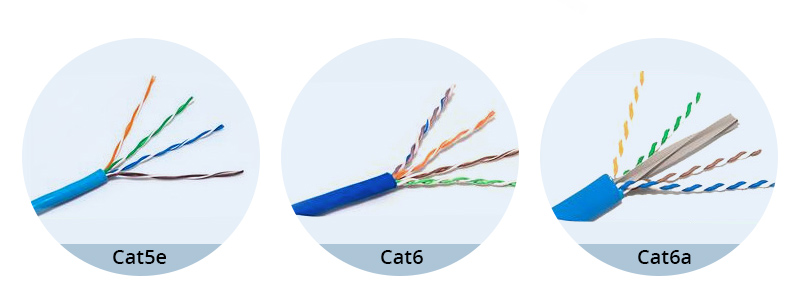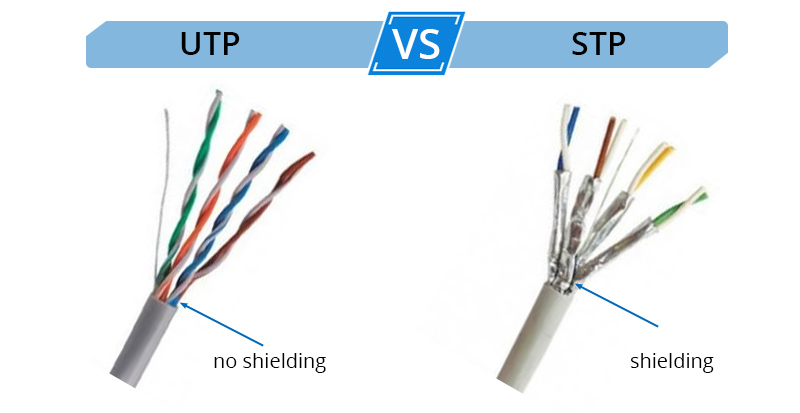UTP vs STP Cable Wiki and Guide
UTP and STP are different types of twisted pair cable, where UTP cable is an unshielded twisted pair cable type, however, STP cable is shielded, they are designed and manufactured in different ways. The UTP and STP cables are used in transmitting information across distances. This guidance will introduce the differences between the two cables in detail to help you choose the right twisted pair Ethernet cable for your data center.
What is UTP Cable?
The unshielded twisted-pair (UTP) cable is the most commonly used telecommunication medium type today, it is composed of color-coded copper in a twisted configuration. The unshielded twisted pair cable does not include any foil or braid as an insulator to avoid interference. The pairs are twisted in the cable so that the UTP patch cable can reduce interference from nearby pairs and other electrical devices.
Offices and homes are the main applications of unshielded twisted pair cable cause there is little interference or crosstalk, the UTP cable price is lower than STP cables, so it is very suitable to deploy an unshielded twisted pair cabling system in a low interference or crosstalk environment to save your cost. When you use UTP cable wiring in strong magnetic fields, it will slow down the network speed or cause network failure. Therefore, you should know the deployed environment in advance before deploying the UTP cable wiring to ensure it works well. Unshielded twisted pair cable is easy to install and STP twisted pair cable is difficult to install because the cable is larger, heavier, and harder.
There are three common UTP cable types. CAT5e: CAT5e contains four twisted pairs. It supports a maximum transmission rate of 1 Gbps, 100 MHz bandwidth for 100 meters. CAT6: CAT6 UTP cable contains four tightly wound twisted pairs. It supports a maximum transmission rate of 1 Gbps, 250 MHz bandwidth, for up to 100 meters and 10 Gbps for up to 55 meters. CAT6A: Up to 10Gbps speed, 500 MHz bandwidth, 100 meters distance. Learn more about the category of UTP cable here.

Figure 1: Cat5e vs Cat6 vs Cat6e
What is STP Cable?
STP stands for Shielded Twisted Pair, There is copper tape inside the shielded twisted pair cable, a layer of conducting polymer or a braid mostly made of copper, and extra foil wrapping. These shielding measures inside the STP cable prevent electromagnetic interference from leaking out of or into the cable. The shielded twisted pair can dispel inductance and capacitive coupling, the inductive coupling is canceled out by Twisting, and the capacitive coupling is eliminated by the shield.
STP twisted pair cable cables are very suitable for deployment in places near equipment that may cause EMI (Electro-Magnetic Interference), such as airports and medical centers, where are many places where interference will occur. Another case is that strong electromagnetic interference will also occur near high-power machines such as microwave ovens. Shielded twisted pair cable can also work well in outdoor conditions, when shielded twisted pair is deployed in the outdoor monitoring system, the monitoring camera won't be disturbed by electromagnetic interference, which can avoid criminals from using jammers to affect the operation of the monitoring system.

Figure 2: UTP VS. STP
The Difference Between UTP VS STP Cable
Alien Crosstalk
Alien Crosstalk is crosstalk generally produced in adjacent cables and connecting hardware. It is a phenomenon that exists in the transmission of copper media. It is also an important performance to investigate whether the performance of copper cables is excellent. When the copper wire is applied to a 10GBASE-T transceiver, alien crosstalk will greatly affect the performance of the copper cable.
In an STP twisted pair cable, the foil screens within the cable can prevent signal coupling, as long as the installed and bonded STP cables are correct, alien crosstalk below required performance levels can be achieved. However, the unshielded twisted pair cables do not have any measures to prevent alien crosstalk. When adjacent cables are close together, external crosstalk will increase.
Termination
STP cables have a shielding layer around each individual pair, therefore STP cables are not easy to terminate, making cable management more difficult. Before termination, the foil and drain wire in the shielded twisted pair cable need to be pulled back and wound around the cable end, and the unused foil also should be trimmed. But there is no insulation such as extra foil wrapping in unshielded twisted pair cables.
As a result, for managers, termination becomes very easy, and the termination spends more time for STP cabling than the UTP link. The patch cables do not need this process, cause they are with connectors, the termination is only suiting for bulk cables.
Bonding and Grounding
The STP and UTP cable connectors are most used in 10GBASE-T modules. While installing a 10GBASE-T copper cabling, only when the bonding and grounding system is completely installed can all the performance of the system be utilized. Deploying an unshielded twisted pair cabling connection does not need to complete system bonding, but you need to guarantee when installing integrity of the grounding of the patch panels and racks to the common grounding point to ensure the stable operation of the infrastructure. And in an STP cabling system, you must bond cable to the connectivity components to ensure adequate performance.
Costs
There are two aspects that affect the cost of STP and UTP cables. For one thing, the shielding material is designed inside the shielded twisted pair cable brings more cost, the costs of UTP patch cable and unshielded connection hardware includes jacks and patch panels are often lower than that of shielded counterparts. For another, STP twisted pair cable cabling solutions will spend more time to terminate the jack modules and correctly bond the cabling system during installation, this will make the installation cost higher. UTP links are simpler to operate and faster to terminate, cutting down the final costs.
There is a parameter summarized in the following table:
| Parameter | UTP | STP |
| Structure | Cable with wires twisted together | Twisted pair cable enclosed in foil & shield |
| Cost | Cheaper | Costlier |
| Bonding and Grounding of cable | Not required | Required |
| Alien Crosstalk | High | Low |
| Termination | Easier to terminate and saves time | Not easy and takes a longer time. |
| Target deployments | Location less prone to interference like offices and homes | Locations prone to interference like factories and airports |
Conclusion
Choosing the right type of twisted pair cable can improve your network performance and prolong the service life of the equipment. After reading this article, I believe that you already know the difference between UTP and STP twisted pair cable cables and how to choose the right type of twisted pair cable.
When there is no strong electromagnetic environment, you can choose unshielded twisted pair cables, and the UTP patch cable price is friendly to a tight budget. When you need to avoid being disturbed by electromagnetic interference, you must consider using more expensive STP cables, which can also be operated under outdoor conditions. QSFPTEK provides a variety of cables for your data center. If you have any questions, contact [email protected].
Get more information about optical fibers:
OM1 OM2 OM3 OM4 OM5 Multimode Fiber Types: What’s the Difference?
The Ultimate Guide to Choose Between OS1 and OS2
Five Differences Between OM3 vs OM4 Fiber










